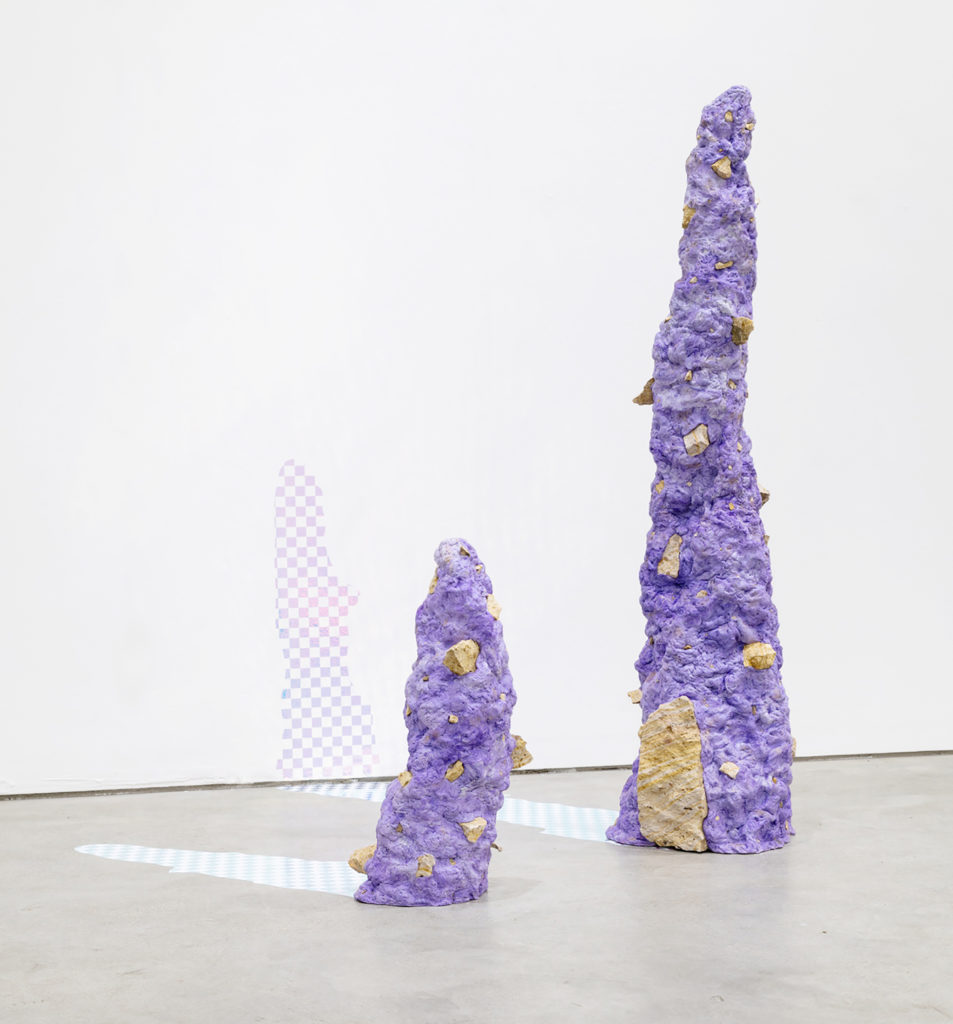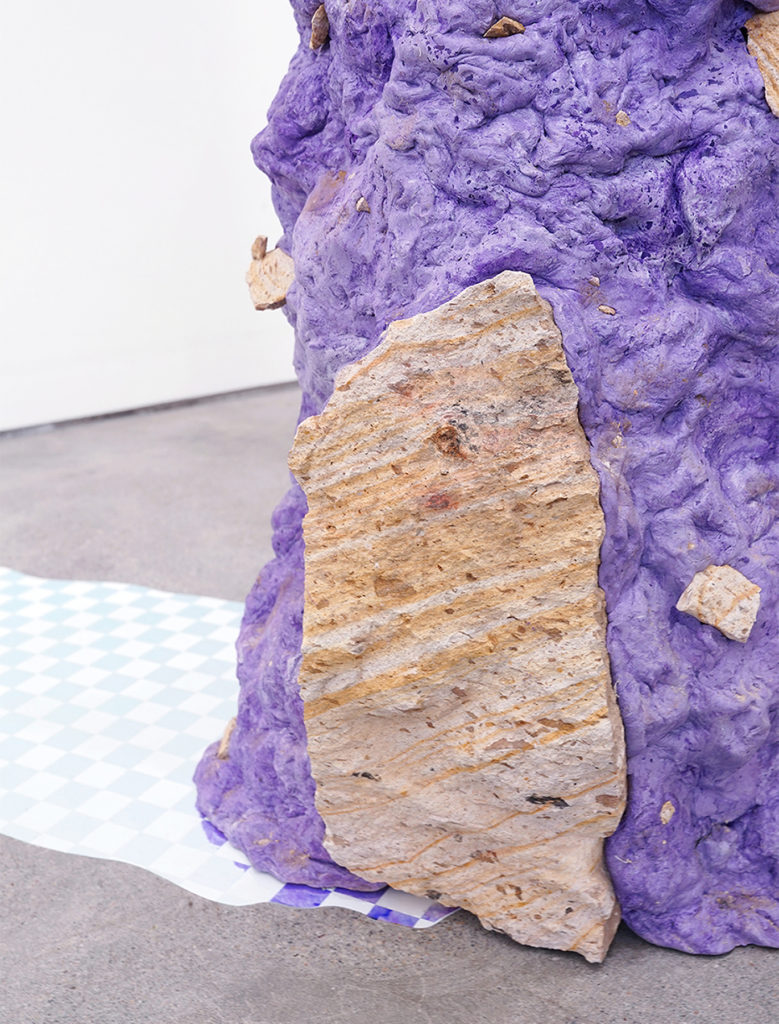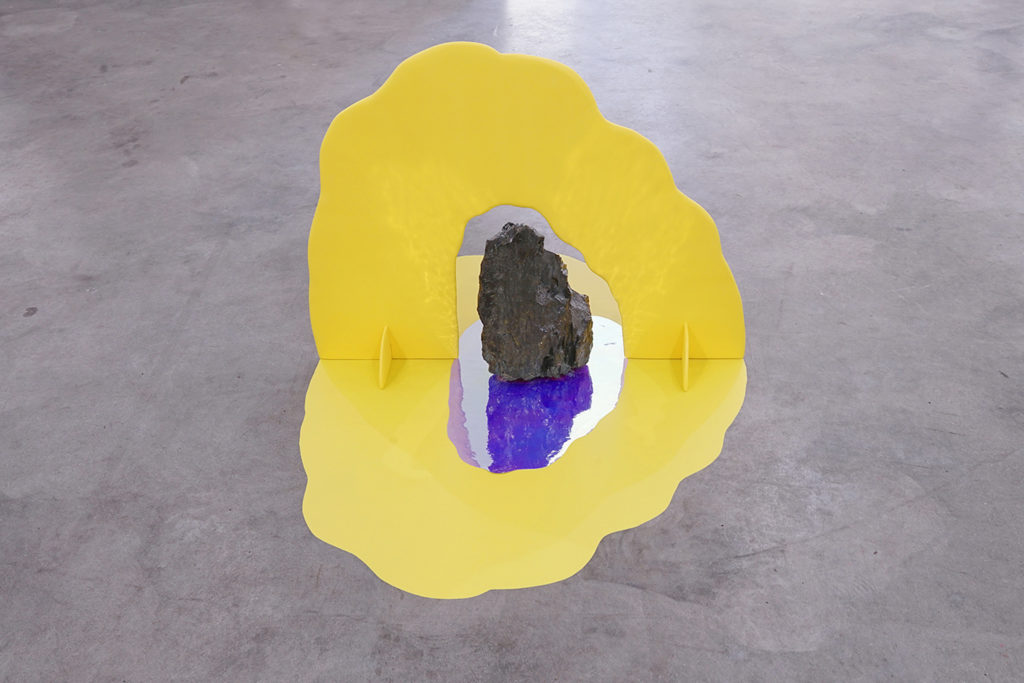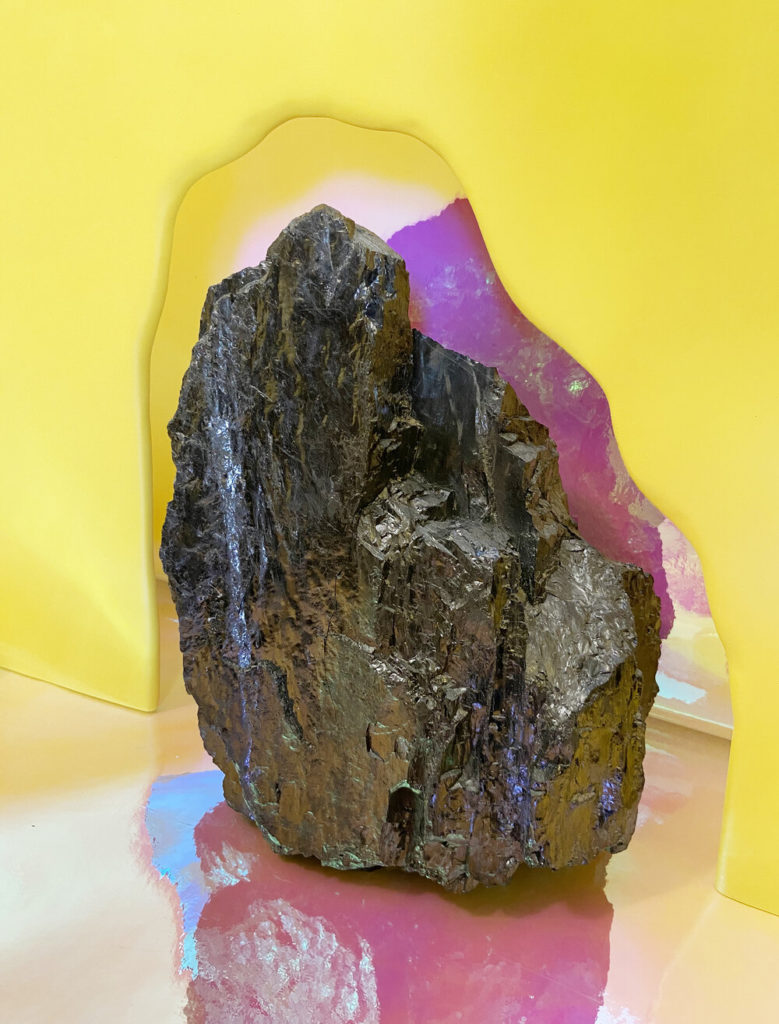Hannah Newman

Hannah Newman, Lumps That Leak / Soft Bodies, 2021, epoxy clay, flocking, smartphones, charging cables, single-channel videos, vinyl, and paint. Image courtesy Mario Gallucci.

Hannah Newman, Lumps That Leak / Soft Bodies, 2021, epoxy clay, flocking, smartphones, charging cables, single-channel videos, vinyl, and paint (detail). Image courtesy Mario Gallucci.
The body is porous—
a lumpy, lukewarm accumulation
of soft-bodied life.[1]
On closer inspection,
the lumps bulge
upward to collect the rising
oil and gas. They welcome[2]
a daylight that works
freely upon them.[3]
A body is an idea—
atoms loosely clumped
together, vibrating
in empty space.
Bodies without surface,
whether once buried
in the mountain, imprisoned
in the nugget, embedded
in a global supply chain,
or swallowed
in the mud, circulate.[4]
Without being seen,
they are discernible only
by the objects they move
through and erode.[5]
These viral bodies flow–
polymorphous–
an ongoing stream
of data and events.[6]
They leak
radiation into the space
and objects surrounding them.[7]
Solid matter is the end
result of long processes
of a natural historical kind.[8]
Soft bodies and hard
plastics take an era
to assemble.
[1] Bishop, Ellen Morris. In Search of Ancient Oregon: A Geological and Natural History, (Portland: Timber Press, 2006), 29.
[3] Focillon, Henri. The Life of Forms in Art, (New York: Wittenborn, Schultz, 1948), 362.
[5] Hunt, Jamer. “Just Re-Do It: Tactical Formlessness and Everyday Consumption,” (Minneapolis: Walker Art Center, 2003), 56, quoting Michel De Certeau.
[6] Hunt. “Just Re-Do It,” 57-58.
[7] Puntar, Diana. (@helzergallery Instagram, Feb. 21, 2020).
[8] Parikka, Jussi. A Geology of Media, (Minneapolis: University of Minnesota Press, 2015), 60.
Erosion marks the passage
of time on land and bodies.
Streams dutifully erode
the landscape, carrying[1]
sands that have been worked
and reworked by algorithms.[2]
Data disintegrates
in the wind and rain,
breaking into luscious,
lossy chunks—pulverized.
Bits of matter
provide traces
of an analog landscape.
The atmosphere is heavy
with metals and minerals[3]
gone viral, atomized dust—[4]
residue from polished ipads,
circulating as memes.[5]
There is no line of narration
more concrete than a stream of dust.[6]
Each particle of dust
carries with it
a unique vision
of matter, movement and interaction.[7]
Dust does not stay
outside a body,
but rather is a history
that enters in.[8]
It is the residue
of a utopian promise registered
in the soft tissue
of a globally distributed,
cheap labor force.[9]
Lungs work in tandem,
easily exhausted[10]
by the coal-fired computing
that supports the existence
of glossy and glassy products.[11]
All the dust settles
on your shoulders:
an as-yet-thin
layer of sediment,
which will grow thicker,
until you disappear.[12]
[1] Bishop, Ellen Morris. In Search of Ancient Oregon: A Geological and Natural History, (Portland: Timber Press, 2006), 98.
[2] King, Hobart M. “Sandstone,” https://geology.com/rocks/sandstone.shtml.
[3] Parikka, Jussi. A Geology of Media, (Minneapolis: University of Minnesota Press, 2015), 92.
[6] Ibid, quoting writer and philosopher Reza Negarestani, 102.
[7] Ibid, quoting Negarestani.
[12] Chevillard, Eric. Prehistoric Times, (New York: Archipelago, 2012), 75.

Hannah Newman, Plastic and Ready To Mold / Aggregate, 2020, epoxy clay, paint, and sedimentary rock. Image courtesy Mario Gallucci.

Hannah Newman, Plastic and Ready To Mold / Aggregate, 2020, epoxy clay, paint, and sedimentary rock. Image courtesy Mario Gallucci.

Hannah Newman, Precarious Bodies / Energy, 2020, epoxy clay, coal, paint, vinyl. Image courtesy of the artist.
Energy is hard to come by
originating from the sun,
and other slowly dying stars.
The microchipped world burns
in intensity like millions
of tiny suns.[1]
Precarious bodies
need to constantly prove
economically viable.[2]
Unstable horizons
harness energy for the production
of free-form algorithms
that shift in and out of focus.
Hard work and hardware,[3]
earth is a massive heat engine,
cooled by millions of computer
server exhaust fans.
We receive energy,
and a supply of lava,
from the stones that slip
constantly down
into the earth’s molten core.[4]
A metal is defined
by what it can do.[5]
Most rocks have,
as yet, proven
of little economic value.[6]
Instability is a gold mine
without a bottom.[7]
A laboring body transforms
energy from potential
to kinetic, releasing
energy back to the sun
in usable packets.
My smartphone puts itself to sleep,
going into energy-saving mode.[8]
We should not expect
easy heroism from such acts.[9]
We are all tired.

Hannah Newman, Precarious Bodies / Energy, 2020, epoxy clay, coal, paint, vinyl (detail). Image courtesy of the artist.
[1] Parikka, Jussi. A Geology of Media, (Minneapolis: University of Minnesota Press, 2015), 138.
[2] Pereira, Lidia. “Towards An Incoherent Refusal of Efficiency,” (Pervasive Labour Union Zine #11, 2018), https://iluservus.at/towards-an-incoherent-refusal-of-efficienty.html.
[4] Bishop, Ellen Morris. In Search of Ancient Oregon: A Geological and Natural History, (Portland: Timber Press, 2006) 29.
[7] Steyerl, Hito. Duty-Free Art: Art in the Age of Planetary Civil War, (London: Verso, 2017), 3.
[8] Parikka. A Geology, page not found.
[9] Haiven, Max. “Currencies of the Undercommons: The Hidden Ledger of Proletarian Money Sabotage,” (State Machines: Reflections and Actions at the Edge of Digital Citizenship, Finance, and Art, Amsterdam: Institute of Network Cultures, 2019), 104.
Hannah Newman is an interdisciplinary artist reuniting digital technologies and experiences with their physical, emotional, and material sources. She has exhibited with galleries and artist-run spaces across the U.S. and is a co-founder of the collective WAVE Contemporary and a member of the artist-run gallery Carnation Contemporary. Based in Portland OR, Newman received a Master of Fine Arts from Oregon College of Art and Craft and a B.S in Ceramics and Fine Arts from Indiana Wesleyan University.